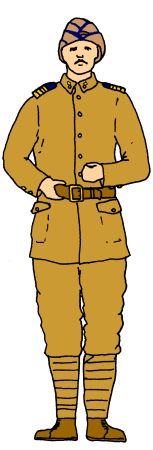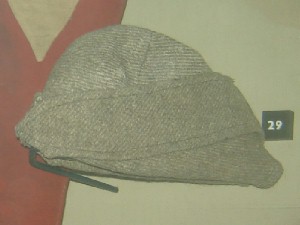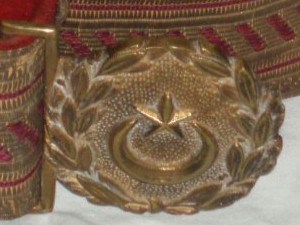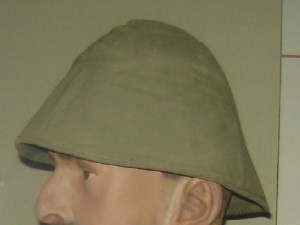German Officers
and NCOs in Ottoman Army Uniforms Ottoman army uniforms had been modernised
in 1909 from their 1890 dark blue uniforms with a red fez (which was still
used as full dress) to a dark khaki uniform with the Kabalak or Kalpak headdress. The topic of Ottoman army uniforms is huge, this page is
only a brief guide to their appearance as worn by German personnel. For
more on Ottoman army uniforms, I would recommend "The Ottoman Army
1914-18" by D Nicolle and R Ruggeri (published by
Osprey)
as a good starting point.
Arm of Service Colour
* The Ottoman Air Force used red as an arm of service colour from 1915 onwards. Prior to that they were part of the engineers and wore their blue insignia with a white metal balloon badge on the collars. Headdress The 1909 Kalpak was a peakless black lambs wool cap (light grey wool for senior officers) worn by officers. It had a cloth top (in arm of service colour) with a three strips of white or yellow metallic lace crossing each other in the centre. Some Kalpaks had a metal unit or crescent badge worn at the front. The Fez was the traditional headdress of the Ottoman army from the 1840s on and was still in use by some units off duty and on parade. Some period photographs also show it being worn by Germans in the Ottoman army. The Ottoman fez was made of red felt, and was conical in shape with a flat top and a black tassel. Uniforms The 1890 Full Dress Uniform of the Ottoman army was in dark blue and was based on the Prussian model. It had a standing collar, eight brass buttons down the front and Swedish cuffs. Collar, cuffs and piping were in arm of service colour. Variations on this uniform existed for different ranks and arms of service with some being double breasted, others having Polish cuffs. Epaulettes replaced the usual officers shoulder boards on parade. Combinations of German and Ottoman Uniforms were not uncommon. A seemingly popular combination among officers was to wear the Ottoman officers kalpak with a German field grey uniform. Many period photographs showing groups of German officers together show some wearing German and others wearing Ottoman uniforms. The Illustrations Figure 1 is based on a photograph of Carl Mühlman, an Officer of the German Military Mission to the Ottoman Empire taken in Istanbul in 1913. He wears Ottoman army full dress uniform. As described above it was based on the Prussian model and looks very similar to the dark blue uniform worn by the German army of the period. Collar, cuffs, piping and epaulettes are in arm of service colour (in this case crimson for staff officers), with officers yellow metallic braid edgings. His Ottoman army officers belt is again very similar to the German design but in yellow metallic braid with crimson stripes (see above). He wears yellow metallic aiguillette cords across his right chest denoting him as an aide de camp. His headdress is the Kalpak lambs wool cap.
Figure 2 is based on a photograph of a German Artillery NCO probably serving on the Gallipoli Front in about 1916. He wears Ottoman army uniform including the Kabalak headgear with its khaki cloth edged in arm of service colour (in this case dark blue for artillery) and has an unidentified brass badge at the front. His Ottoman army tunic is dark khaki with the two cuff buttons usually only seen on officers' clothing. The stand and fall collar has a brass flaming grenade badge button on each front corner- the insignia of the Ottoman heavy siege artillery. The shoulder straps are in arm of service colour (in this case artillery dark blue) with four bars of yellow metallic lace stripes to define the rank as Specialist Sergeant Major ("Chief"). Shoulder straps were sometimes removed by Ottoman soldiers in action. He wears matching dark khaki trousers and puttees with brown leather ankle boots. Figure 3 is based on a photograph of a Senior German Officer (possibly Oberst Kress von Kressenstein) taken in 1918 while inspecting Ottoman troops. He wears a privately tailored Ottoman officers' uniform consisting of a lambs wool Kalpak and an olive green tunic with a darker green collar (the infantry's arm of service colour). The plain turn back cuffs and breast pockets with pointed flaps are variations due to private tailoring. Braided shoulder straps show his rank. This officer wears an Iron Cross second class ribbon in his second buttonhole. He quite probably also wears more German and Ottoman medals on the left breast that cannot be seen from the angle of the original photograph upon which this illustration was based. He wears riding breeches in a lighter shade with black leather gaiters and boots.
Thanks to Chris Flaherty and Cristiano Campos for their help in researching this page.
|





